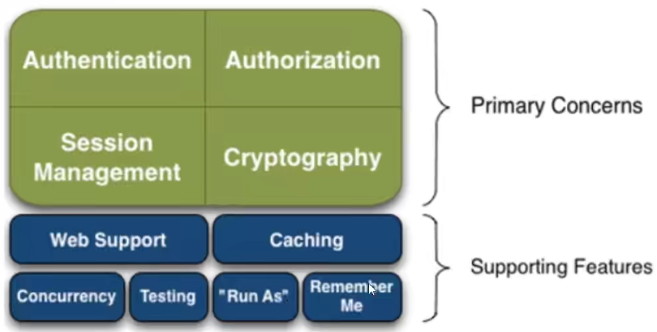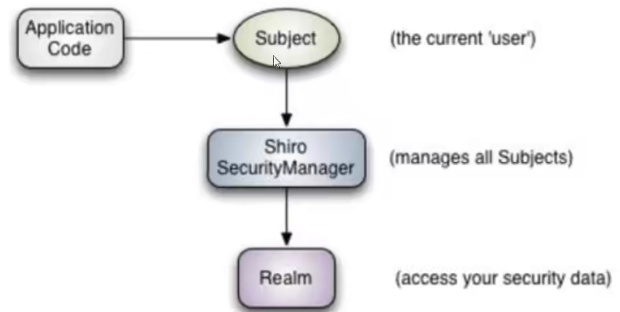一.Shiro简介
1.什么是Shiro
-
Apache Shiro是一个Java安全(权限)框架
-
Shiro可以非常容易的开发出足够好的应用,其不仅可以用在JavaSE环境,也可以用在JavaEE环境。
-
Shiro可以完成认证、授权、加密、会话管理、Web集成以及缓存等
-
下载地址:http://shiro.apache.org
2.功能

-
Authentication:身份认证、登录、验证用户是不是拥有相应的身份
-
Authorization:授权,即权限验证,验证某个已认证用户是否拥有某个权限,判断用户能否进行什么操作,例如:验证某个用户是否拥有某个角色,或者细粒度的验证某个用户对某个资源是否具有某个权限
-
Session Manager:会话管理,即用户登录后就是第一次会话,在没有退出之前,它的所有信息都在绘画中;会话可以是普通的JavaSE环境,也可以是Web环境
-
Cryptography:加密,保护数据的安全性,如密码加密存储在数据库中,而不是明文存储
-
Web Support:Web支持,可以非常容易集成到Web环境
-
Caching:缓存,比如用户登录后,其用户信息,拥有的角色、权限不比每次去查,这样可以提高效率
-
Concurrency:Shiro支持多线程应用的并发验证,即在一个线程中开启另一个线程,能把权限自动的传播过去
-
Testing:提供测试支持
-
Run As:允许一个用户假装为另一个用户(如果他们允许)的身份进行访问
-
Remember Me:记住我,即一次登录后下次就不用再登录了
3.Shiro架构(外部)
(1)从应用程序角度来观察如何使用shiro完成工作:

(2)核心对象
-
subject:应用代码直接交互的对象是Subject,也就是说Shiro的对外API核心就是Subject,Subject代表了当前的用户,这个用户不一定是一个具体的人,与当前应用交互的任何东西都是Subject,如网络爬虫、机器人等,与Subject的所有交互都会委托给SecurityManager,Subject其实是一个门面,SecurityManager才是实际的执行者
-
SecurityManager:安全管理器,即所有与安全有关的操作都会与SecurityManager交互,并且它管理着所有的Subject,可以看出它是Shiro的核心,它负责与Shiro的其他组件交互,相当于SpringMVC的DispatcherServlet的角色
-
Realm:Shiro从Realm获取安全数据(如用户,角色,权限),就是说SecurityManager要验证用户身份,需要从Realm获取相应的用户进行比较,来确定用户的身份是否合法,也需要从Realm得到用户相应的角色、权限进行验证用户的操作是否能够进行,可以把Realm看成DataSource。
4.Shiro框架(内部)

二.Shiro快速开始
1.步骤
-
搭建普通maven项目(略)
-
pom.xml中导入依赖
-
编写配置文件shiro.ini和log4j.propreties
-
编写Java类
-
测试执行
2.pom.xml中导入依赖
<dependencies>
<dependency>
<groupId>org.apache.shiro</groupId>
<artifactId>shiro-core</artifactId>
<version>1.4.1</version>
</dependency>
<!-- configure logging -->
<dependency>
<groupId>org.slf4j</groupId>
<artifactId>jcl-over-slf4j</artifactId>
<version>1.7.21</version>
</dependency>
<dependency>
<groupId>org.slf4j</groupId>
<artifactId>slf4j-log4j12</artifactId>
<version>1.7.21</version>
</dependency>
<dependency>
<groupId>log4j</groupId>
<artifactId>log4j</artifactId>
<version>1.2.17</version>
</dependency>
</dependencies>
3.编写配置文件shiro.ini和log4j.propreties放到resources目录下
shiro.ini
[users]
# user 'root' with password 'secret' and the 'admin' role
root = secret, admin
# user 'guest' with the password 'guest' and the 'guest' role
guest = guest, guest
# user 'presidentskroob' with password '12345' ("That's the same combination on
# my luggage!!!" ;)), and role 'president'
presidentskroob = 12345, president
# user 'darkhelmet' with password 'ludicrousspeed' and roles 'darklord' and 'schwartz'
darkhelmet = ludicrousspeed, darklord, schwartz
# user 'lonestarr' with password 'vespa' and roles 'goodguy' and 'schwartz'
lonestarr = vespa, goodguy, schwartz
# -----------------------------------------------------------------------------
# Roles with assigned permissions
#
# Each line conforms to the format defined in the
# org.apache.shiro.realm.text.TextConfigurationRealm#setRoleDefinitions JavaDoc
# -----------------------------------------------------------------------------
[roles]
# 'admin' role has all permissions, indicated by the wildcard '*'
admin = *
# The 'schwartz' role can do anything (*) with any lightsaber:
schwartz = lightsaber:*
# The 'goodguy' role is allowed to 'drive' (action) the winnebago (type) with
# license plate 'eagle5' (instance specific id)
goodguy = winnebago:drive:eagle5
log4j.propreties
log4j.rootLogger=INFO, stdout
log4j.appender.stdout=org.apache.log4j.ConsoleAppender
log4j.appender.stdout.layout=org.apache.log4j.PatternLayout
log4j.appender.stdout.layout.ConversionPattern=%d %p [%c] - %m %n
# General Apache libraries
log4j.logger.org.apache=WARN
# Spring
log4j.logger.org.springframework=WARN
# Default Shiro logging
log4j.logger.org.apache.shiro=INFO
# Disable verbose logging
log4j.logger.org.apache.shiro.util.ThreadContext=WARN
log4j.logger.org.apache.shiro.cache.ehcache.EhCache=WARN
4.编写Java类
import org.apache.shiro.SecurityUtils;
import org.apache.shiro.authc.*;
import org.apache.shiro.config.IniSecurityManagerFactory;
import org.apache.shiro.mgt.SecurityManager;
import org.apache.shiro.session.Session;
import org.apache.shiro.subject.Subject;
import org.apache.shiro.util.Factory;
import org.slf4j.Logger;
import org.slf4j.LoggerFactory;
public class Quickstart {
private static final transient Logger log = LoggerFactory.getLogger(Quickstart.class);
public static void main(String[] args) {
// 读取配置文件
Factory<SecurityManager> factory = new IniSecurityManagerFactory("classpath:shiro.ini");
SecurityManager securityManager = factory.getInstance();
SecurityUtils.setSecurityManager(securityManager);
//获取当前的用户对象Subject
Subject currentUser = SecurityUtils.getSubject();
//通过当前用户对象拿到Session
Session session = currentUser.getSession();
session.setAttribute("someKey", "aValue");
String value = (String) session.getAttribute("someKey");
if (value.equals("aValue")) {
log.info("Retrieved the correct value! [" + value + "]");
}
//判断当前的用户对象是否被认证
if (!currentUser.isAuthenticated()) {
//Token:令牌
UsernamePasswordToken token = new UsernamePasswordToken("lonestarr", "vespa");
token.setRememberMe(true); //记住我
try {
currentUser.login(token); //执行登录操作
} catch (UnknownAccountException uae) {
log.info("There is no user with username of " + token.getPrincipal());
} catch (IncorrectCredentialsException ice) {
log.info("Password for account " + token.getPrincipal() + " was incorrect!");
} catch (LockedAccountException lae) {
log.info("The account for username " + token.getPrincipal() + " is locked. " +
"Please contact your administrator to unlock it.");
}
// ... catch more exceptions here (maybe custom ones specific to your application?
catch (AuthenticationException ae) {
//unexpected condition? error?
}
}
//say who they are:
//print their identifying principal (in this case, a username):
log.info("User [" + currentUser.getPrincipal() + "] logged in successfully.");
//test a role:
if (currentUser.hasRole("schwartz")) {
log.info("May the Schwartz be with you!");
} else {
log.info("Hello, mere mortal.");
}
//粗粒度
//test a typed permission (not instance-level)
if (currentUser.isPermitted("lightsaber:wield")) {
log.info("You may use a lightsaber ring. Use it wisely.");
} else {
log.info("Sorry, lightsaber rings are for schwartz masters only.");
}
//细粒度
//a (very powerful) Instance Level permission:
if (currentUser.isPermitted("winnebago:drive:eagle5")) {
log.info("You are permitted to 'drive' the winnebago with license plate (id) 'eagle5'. " +
"Here are the keys - have fun!");
} else {
log.info("Sorry, you aren't allowed to drive the 'eagle5' winnebago!");
}
//注销
//all done - log out!
currentUser.logout();
//结束
System.exit(0);
}
}
5.测试执行

6.主要的代码分析
Subject currentUser = SecurityUtils.getSubject();//获取当前的用户对象Subject
Session session = currentUser.getSession();//通过当前用户对象拿到Session
currentUser.isAuthenticated();//判断当前的用户对象是否被认证
token.setRememberMe(true); //记住我
currentUser.login(token); //执行登录操作
token.getPrincipal();//获得token认证
currentUser.getPrincipal();//获得当前用户的认证
currentUser.hasRole("schwartz");//是否拥有xxx角色
currentUser.isPermitted("lightsaber:wield");//是否拥有xxx权限
currentUser.logout();//注销
三.SpringBoot集成Shiro
1.步骤
-
搭建springboot项目环境带mvc和thymeleaf(略)
-
pom.xml中导入依赖
-
编写Java Config配置
-
编写控制器
-
编写页面
2.pom.xml中导入依赖
<!--shiro整合spring的包-->
<dependency>
<groupId>org.apache.shiro</groupId>
<artifactId>shiro-spring</artifactId>
<version>1.5.1</version>
</dependency>
3.编写Java Config配置
添加config包,在config包中添加UserRealm.java
import org.apache.shiro.authc.AuthenticationException;
import org.apache.shiro.authc.AuthenticationInfo;
import org.apache.shiro.authc.AuthenticationToken;
import org.apache.shiro.authz.AuthorizationInfo;
import org.apache.shiro.realm.AuthorizingRealm;
import org.apache.shiro.subject.PrincipalCollection;
//自定义的UserRealm需要继承AuthorizingRealm
public class UserRealm extends AuthorizingRealm {
@Override
protected AuthorizationInfo doGetAuthorizationInfo(PrincipalCollection principalCollection) {
System.out.println("执行了=>授权doGetAuthorizationInfo");
return null;
}
@Override
protected AuthenticationInfo doGetAuthenticationInfo(AuthenticationToken authenticationToken) throws AuthenticationException {
System.out.println("执行了=>认证doGetAuthorizationInfo");
return null;
}
}
在config包中添加ShiroConfig.java
import org.apache.shiro.spring.web.ShiroFilterFactoryBean;
import org.apache.shiro.web.mgt.DefaultWebSecurityManager;
import org.springframework.beans.factory.annotation.Qualifier;
import org.springframework.context.annotation.Bean;
import org.springframework.context.annotation.Configuration;
@Configuration
public class ShiroConfig {
/*
Subject: 用户
SecurityManager:管理所有用户
Realm:连接数据
*/
//ShiroFilterFactoryBean
@Bean
public ShiroFilterFactoryBean getShiroFilterFactoryBean(@Qualifier("securityManager") DefaultWebSecurityManager defaultWebSecurityManager){
ShiroFilterFactoryBean bean = new ShiroFilterFactoryBean();
//设置安全管理器
bean.setSecurityManager(defaultWebSecurityManager);
return bean;
}
//DefaultWebSecurityManager
@Bean(name = "securityManager")
public DefaultWebSecurityManager getDefaultWebSecurityManager(@Qualifier("userRealm") UserRealm userRealm){
DefaultWebSecurityManager securityManager = new DefaultWebSecurityManager();
//关联userRealm
securityManager.setRealm(userRealm);
return securityManager;
}
//创建Realm对象,需要自定义的Realm对象
@Bean
public UserRealm userRealm(){
return new UserRealm();
}
}
4.编写控制器
-
添加controller包并在其中添加MyController.java
import org.springframework.stereotype.Controller;
import org.springframework.ui.Model;
import org.springframework.web.bind.annotation.RequestMapping;
@Controller
public class MyController {
@RequestMapping({"/","/index"})
public String toIndex(Model model){
model.addAttribute("msg","hello,shiro");
return "index";
}
@RequestMapping("/user/add")
public String add(){
return "user/add";
}
@RequestMapping("/user/update")
public String update(){
return "user/update";
}
@RequestMapping("/toLogin")
public String toLogin(){
return "login";
}
}
5.编写页面
index.html


<!DOCTYPE html>
<html lang="en" xmlns:th="http://www.thymeleaf.org">
<head>
<meta charset="UTF-8">
<title>index</title>
</head>
<body>
<h1>首页</h1>
<p th:text="${msg}"></p>
<hr>
<a th:href="@{/user/add}">add</a> | <a th:href="@{/user/update}">update</a>
</body>
</html>
View Codeadd.html


<!DOCTYPE html>
<html lang="en">
<head>
<meta charset="UTF-8">
<title>Title</title>
</head>
<body>
<h1>add</h1>
</body>
</html>
View Codeupdate.html


<!DOCTYPE html>
<html lang="en">
<head>
<meta charset="UTF-8">
<title>Title</title>
</head>
<body>
<h1>update</h1>
</body>
</html>
View Codelogin.html


<!DOCTYPE html>
<html lang="en">
<head>
<meta charset="UTF-8">
<title>login</title>
</head>
<body>
<h1>登录</h1>
<hr>
<form action="">
<p>用户名:<input type="text" name="username"></p>
<p>密码:<input type="text" name="password"></p>
<p><input type="submit"></p>
</form>
</body>
</html>
View Code基本环境搭建成功!
四.Shiro实现登录拦截
1.修改ShiroConfig.java文件
-
设置对user路径下的所有文件必须认证才能访问
-
如果认证失败跳转登录页
//ShiroFilterFactoryBean
@Bean
public ShiroFilterFactoryBean getShiroFilterFactoryBean(@Qualifier("securityManager") DefaultWebSecurityManager defaultWebSecurityManager){
ShiroFilterFactoryBean bean = new ShiroFilterFactoryBean();
//设置安全管理器
bean.setSecurityManager(defaultWebSecurityManager);
/*
anno: 无需认证就可以登录
authc:必须认证了才能访问
user:必须拥有记住我功能才能访问
perms:拥有对某个资源的权限才能访问
role:拥有某个角色权限才能访问
*/
Map<String,String> filterMap = new LinkedHashMap<>();
// filterMap.put("/user/add","authc");
// filterMap.put("/user/update","authc");
filterMap.put("/user/*","authc");
bean.setFilterChainDefinitionMap(filterMap);
//设置登录的请求
bean.setLoginUrl("/toLogin");
return bean;
}
五.Shiro实现用户认证集成Mybatis
1.步骤
-
pom.xml中添加依赖
-
连接数据库配置pojo,mapper,service层以及xxxMapper.xml(略)
-
修改登录页面
-
编写application.yml
-
控制其中添加方法
-
UserRealm.java中修改认证方法
2.pom.xml中添加依赖
-
MySQL、Mybatis、Druid、log4j、lombok


<!--MySQL-->
<dependency>
<groupId>mysql</groupId>
<artifactId>mysql-connector-java</artifactId>
<scope>runtime</scope>
</dependency>
<!-- 引入 myBatis,这是 MyBatis官方提供的适配 Spring Boot 的,而不是Spring Boot自己的-->
<dependency>
<groupId>org.mybatis.spring.boot</groupId>
<artifactId>mybatis-spring-boot-starter</artifactId>
<version>2.1.0</version>
</dependency>
<!--Druid-->
<dependency>
<groupId>com.alibaba</groupId>
<artifactId>druid</artifactId>
<version>1.1.21</version>
</dependency>
<!--Log4j-->
<dependency>
<groupId>log4j</groupId>
<artifactId>log4j</artifactId>
<version>1.2.17</version>
</dependency>
<!--lombok-->
<dependency>
<groupId>org.projectlombok</groupId>
<artifactId>lombok</artifactId>
<optional>true</optional>
</dependency>
View Code3.修改登录页面
<!DOCTYPE html>
<html lang="en" xmlns:th="http://www.thymeleaf.org">
<head>
<meta charset="UTF-8">
<title>login</title>
</head>
<body>
<h1>登录</h1>
<hr>
<p th:text="${msg}" style="color:red"></p>
<form th:action="@{/login}" method="post">
<p>用户名:<input type="text" name="username"></p>
<p>密码:<input type="text" name="password"></p>
<p><input type="submit"></p>
</form>
</body>
</html>
4.编写application.yml


spring:
datasource:
username: root
password: 123456
#?serverTimezone=UTC解决时区的报错
url: jdbc:mysql://localhost:3306/mybatis?serverTimezone=UTC&useUnicode=true&characterEncoding=utf-8
driver-class-name: com.mysql.cj.jdbc.Driver
type: com.alibaba.druid.pool.DruidDataSource
#Spring Boot 默认是不注入这些属性值的,需要自己绑定
#druid 数据源专有配置
initialSize: 5
minIdle: 5
maxActive: 20
maxWait: 60000
timeBetweenEvictionRunsMillis: 60000
minEvictableIdleTimeMillis: 300000
validationQuery: SELECT 1 FROM DUAL
testWhileIdle: true
testOnBorrow: false
testOnReturn: false
poolPreparedStatements: true
#配置监控统计拦截的filters,stat:监控统计、log4j:日志记录、wall:防御sql注入
#如果允许时报错 java.lang.ClassNotFoundException: org.apache.log4j.Priority
#则导入 log4j 依赖即可,Maven 地址: https://mvnrepository.com/artifact/log4j/log4j
filters: stat,wall,log4j
maxPoolPreparedStatementPerConnectionSize: 20
useGlobalDataSourceStat: true
connectionProperties: druid.stat.mergeSql=true;druid.stat.slowSqlMillis=500
#指定myBatis的核心配置文件与Mapper映射文件
mybatis:
mapper-locations: classpath:mapper/*.xml
# 注意:对应实体类的路径
type-aliases-package: ustc.wzh.pojo
View Code5.控制其中添加方法
-
此方法接收表单提交的用户名和密码
-
将用户名和密码生成Token交给subject处理会进入验证方法中判断最后返回给此方法,如果验证成功进入index页面失败则还是login页面
@RequestMapping("/login")
public String login(String username, String password, Model model) {
//获得当前的用户
Subject subject = SecurityUtils.getSubject();
//封装用户的登录数据
UsernamePasswordToken token = new UsernamePasswordToken(username, password);
try {
//执行登录的方法
subject.login(token);
return "index";
} catch (UnknownAccountException e) {
//用户名不存在
model.addAttribute("msg", "用户名错误");
return "login";
} catch (IncorrectCredentialsException e) {
//密码不存在
model.addAttribute("msg", "密码错误");
return "login";
}
}
6.UserRealm.java中修改认证方法
@Autowired
UserService userService;
- 从方法参数中获得的Token中拿出用户名,然后在数据库中查找,最后判断用户是否不存在,如果不存在返回null则控制器就会异常处理,存在就跳转
- 此处还可以设置加密方式(https://blog.csdn.net/qq_21046965/article/details/90105915)
@Override
protected AuthenticationInfo doGetAuthenticationInfo(AuthenticationToken authenticationToken) throws AuthenticationException {
System.out.println("执行了=>认证doGetAuthorizationInfo");
UsernamePasswordToken userToken = (UsernamePasswordToken) authenticationToken;
//连接数据库
User user = userService.queryUserByName(userToken.getUsername());
if (user == null) {
return null; //没有获得用户则返回null经过ShiroConfig类中的方法会抛出UnknownAccountException
}
//还可以设置加密方式
return new SimpleAuthenticationInfo("", user.getPwd(), "");
}
六.Shiro实现用户授权
1.步骤
-
控制器添加未授权跳转方法
-
UserRealm.java修改授权方法
-
ShiroConfig.java中修改拦截器方法
2.控制器添加未授权跳转方法
@RequestMapping("/unauth")
@ResponseBody
public String unauthorized(){
return "未经授权无法访问";
}
3.UserRealm.java修改授权方法
-
先修改认证方法返回参数添加一个user用于传递用户对象
return new SimpleAuthenticationInfo(user, user.getPwd(), "");
//授权
@Override
protected AuthorizationInfo doGetAuthorizationInfo(PrincipalCollection principalCollection) {
System.out.println("执行了=>授权doGetAuthorizationInfo");
SimpleAuthorizationInfo info = new SimpleAuthorizationInfo();
//获得当前的登录对象
Subject subject = SecurityUtils.getSubject();
User currentUser = (User) subject.getPrincipal(); //获得认证方法中保存的登录对象
//设置当前用户对象权限
/*
需要在数据库中设置一个权限的属性来控制
此处省去麻烦就直接通过用户名来设置权限
*/
//给root授权
if (Objects.equals(currentUser.getName(),"root")){
info.addStringPermission("user:add"); //添加add权限
System.out.println("root用户授权add");
}
//给张三授权
if (Objects.equals(currentUser.getName(),"张三")){
info.addStringPermission("user:update"); //添加add权限
System.out.println("张三用户授权update");
}
return info;
}
4.ShiroConfig.java中修改拦截器方法
//ShiroFilterFactoryBean
@Bean
public ShiroFilterFactoryBean getShiroFilterFactoryBean(@Qualifier("securityManager") DefaultWebSecurityManager defaultWebSecurityManager) {
ShiroFilterFactoryBean bean = new ShiroFilterFactoryBean();
//设置安全管理器
bean.setSecurityManager(defaultWebSecurityManager);
/*
anno: 无需认证就可以登录
authc:必须认证了才能访问
user:必须拥有记住我功能才能访问
perms:拥有对某个资源的权限才能访问
role:拥有某个角色权限才能访问
*/
//拦截
Map<String, String> filterMap = new LinkedHashMap<>();
// filterMap.put("/user/add","authc");
// filterMap.put("/user/update","authc");
//只有权限为user:add的用户才可以访问user/add
filterMap.put("/user/add","perms[user:add]");
//只有权限为user:update的用户才可以访问user/update
filterMap.put("/user/update","perms[user:update]");
//只有通过认证的用户才可以访问user目录下的文件
filterMap.put("/user/*", "authc");
//设置拦截链
bean.setFilterChainDefinitionMap(filterMap);
//设置未授权的页面
bean.setUnauthorizedUrl("/unauth");
//设置登录的请求
bean.setLoginUrl("/toLogin");
return bean;
}
5.测试成功
七.Shiro整合Thymeleaf
1.步骤:通过判断用户的权限显示不同的页面
-
pom.xml中导入配置
-
ShiroConfig.java添加一个shiro与thymeleaf结合使用的bean
-
修改index页面
2.pom.xml中导入配置
<!--thymeleaf和shiro整合-->
<dependency>
<groupId>com.github.theborakompanioni</groupId>
<artifactId>thymeleaf-extras-shiro</artifactId>
<version>2.0.0</version>
</dependency>
3.ShiroConfig.java添加一个shiro与thymeleaf结合使用的bean
//整合ShiroDialect:用于shiro整合thymeleaf
@Bean
public ShiroDialect getShiroDialect(){
return new ShiroDialect();
}
4.修改index页面
-
添加对thymeleaf和shiro的约束:
xmlns:th="http://www.thymeleaf.org" xmlns:shiro="http://www.thymeleaf.org/thymeleaf-extras-shiro"
-
判断是否登录: th:if="${session.loginUser == null}"
-
判断是否有权限: shiro:hasPermission="user:add"
- <!DOCTYPE html>
<html lang="en" xmlns:th="http://www.thymeleaf.org" xmlns:shiro="http://www.thymeleaf.org/thymeleaf-extras-shiro">
<head>
<meta charset="UTF-8">
<title>index</title>
</head>
<body>
<h1>首页</h1>
<div th:if="${session.loginUser == null}">
<a th:href="@{/toLogin}">登录</a>
</div>
<p th:text="${msg}"></p>
<hr>
<div shiro:hasPermission="user:add">
<a th:href="@{/user/add}">add</a>
</div>
<div shiro:hasPermission="user:update">
<a th:href="@{/user/update}">update</a>
</div>
</body>
</html>
5.测试成功!














